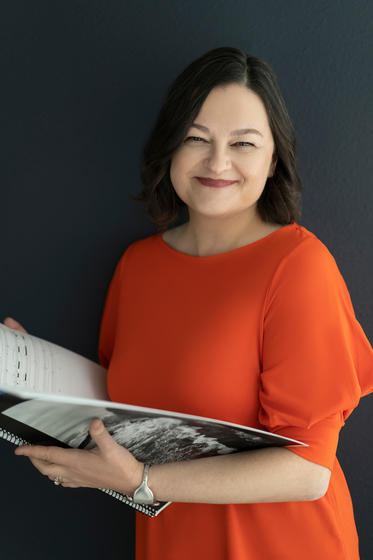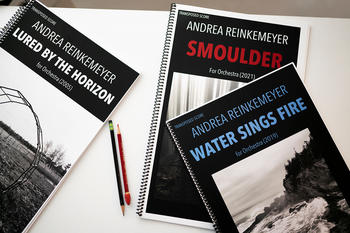In This Story
When Dr. Andrea Reinkemeyer first sat down at a piano as a child, her teacher didn’t just assign scales and practice pieces. She handed over a simple directive: create something.
That early encouragement—to treat music as a space for invention, not just replication—shaped everything that followed. Today, as Associate Professor and Director of Composition at George Mason University’s Dewberry School of Music, Reinkemeyer brings that same spirit of fearless creativity to a new generation of students.
“It was just like giving a kid a crayon,” Reinkemeyer recalls. “You hand it over, and they start drawing. Composing music felt natural to me from the beginning.”

Throughout a career that has spanned new works for orchestras, chamber ensembles, solo performers, and multi-institution commissions, Reinkemeyer has built a reputation for music that defies traditional expectations. Her works often weave together unexpected elements—soundscapes inspired by nature, compositional structures drawn from scientific data, and reflections on urgent social issues like environmental crises and justice movements.
Rather than separating art from the world, Reinkemeyer sees composition as a way to bring listeners deeper into it.
Inspired by the Mariner space program, one piece transformed dates and elemental compounds into musical motifs, turning the exploration of Mars into a shimmering, crystalline soundscape. Another translated the crackle and roar of a wildfire into sonic textures, using crumpled paper within a wind ensemble to capture the chaos and power of a Pacific Northwest forest fire. Still, another, inspired by Leigh Bardugo's short story, When Water Sang Fire, retold a mythic story of resilience through an oceanic, emotionally charged orchestral work.
“Science and storytelling have always fascinated me,” Reinkemeyer says. “Music gives people an emotional connection to things they might otherwise only engage with intellectually.”
In the classroom, Reinkemeyer creates the same kind of space she was fortunate to experience early on—a place where creativity isn’t just allowed but expected. Students are encouraged to listen widely, experiment freely, and take risks they might not have thought possible.

Through initiatives like the New Sound Collective, student composers collaborate with performers, rehearse, revise, and publicly present their original works. In another project with George Mason’s Special Collections Research Center and the Spheres Project, led by Professor June Huang, students create new compositions inspired by archival materials, blending history, research, and music into entirely new expressions.
Assignments are designed to push students beyond comfortable forms. Orchestration courses encourage students to take a fragment of music and reimagine it in three different ways, exploring how sound can transform depending on texture, timbre, and technique.
At every stage, the goal is the same: help students move beyond simply learning the rules of music and give them the confidence to break them thoughtfully.
“When you create a safe space to experiment, that’s when real creativity happens,” Reinkemeyer says. “It’s how students start to discover what they want to say through music.”
That philosophy reflects the larger spirit at George Mason University: a place where innovation, individuality, and bold thinking are not just encouraged but incorporated into the heart of each program.
At George Mason, Reinkemeyer is helping shape a new kind of composer who understands that music can do more than entertain. Through experimentation, collaboration, and a willingness to look beyond traditional forms, students are learning to create work that connects with the world around them. It’s a process that mirrors Reinkemeyer’s career: thoughtful, exploratory, and rooted in the belief that music can expand how we experience and understand the world.
